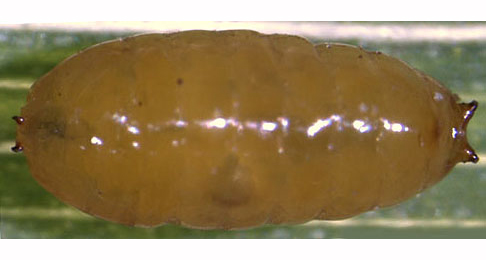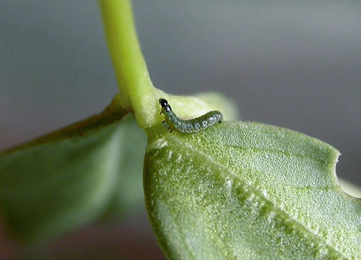|
||||||
|
HYMENOCARPOS. Disk Trefoil. [Fabaceae] |
|
Only one species of Hymenocarpos is recorded in Britain, the introduced Disk Trefoil (H. circinnatus). Four British miners are recorded on Hymenocarpos. A key to the European miners recorded on Hymenocarpos is provided in Bladmineerders van Europa. |
|
Key for the identification of the known mines of British |
1a > Leaf-miner: A distinctive mine primarily above mid-rib, with irregular short lateral offshoots into leaf blade. Pupation external (Spencer, 1972: 51 (fig. 172), 55; Spencer, 1976: 270, 271 (fig. 486)). Branched, whitish, upper-surface corridor; main axis overlying the midrib; side branches overlying the main lateral veins. (In Campanula and Phyteuma the mine is much less branched, sometimes nothing more than a corridor on top of the midrib). Frass in rather long strings. Usually the mines begins as a long and narrow, shallow, tortuous lower-surface corridor that ends upon the midrib but otherwise is not associated with the leaf venation. Often this initial corridor is filled with callus, and then even less conspicuous. Pupation outside the mine. A linear mine on the upper surface, usually following the midrib and showing side branches along the veins. The frass is in strings. |
|
Liriomyza strigata (Meigen, 1830) [Diptera: Agromyzidae]. |
1b > Leaf-miner: An upper or lower surface shallow winding linear mine, which may develop into a secondary blotch. Pupation external (Spencer, 1976: 240). Puparium orange Upper- or lower-surface, greenish or whitish corridor, sometimes a blotch. The corridor does not widen much and is not associated with the midrib. Frass in conspicuous thread fragments, alternating along the sides of the corridor. Pupation outside the mine. The mine is also illustrated in British Leafminers. |
|
| Liriomyza cicerina (Rondani, 1975) [Diptera: Agromyzidae]. |
| 1c > Leaf-miner: Corridor leaf-mine in leaves. An upper surface linear mine
with frass in conspicuous greenish strips, largely alternating at
each side of the channel (Spencer,
1976: 241).
Upper-surface, unbranched corridor, relatively broad from the start on, but only weakly widening subsequently. The fresh mine is bright green, but turns whitish, later brown, quickly. Frass in a wide green band in the centre of the corridor, with small black granules at either side. Pupation outside the mine. Forms an upper surface mine, with the frass in a green strips. |
 Liriomyza congesta puparium Image: © Willem Ellis (Bladmineerders van Europa) |
|
Liriomyza congesta (Becker, 1903) [Diptera: Agromyzidae]. |
1d > Leaf miner: The first generation initially forms an unmistakable leaf-mine on Anthyllis vulneraria, but the second generation feeds on the flowers. Feeding signs on other plants vary in appearance. Larvae can move between sewn leaves, and more than one larva may be found together. Larvae in a small full depth blotch, often with extensions. Frass concentrated in one corner of the mine. The mining activities may cause the leaf to roll inwards. Older larvae live free among spun leaves, but still they may make then full depth mines by feeding on the leaf tissue from a small opening. |
 Aproaerema anthyllidella larva, dorsal Image: © Steve Wullaert (Bladmineerders van Europa) |
|
Aproaerema anthyllidella (Hübner, 1813) [Lepidoptera: Gelechiidae]. |
| Last updated 05-Jul-2019 Brian Pitkin | ||
